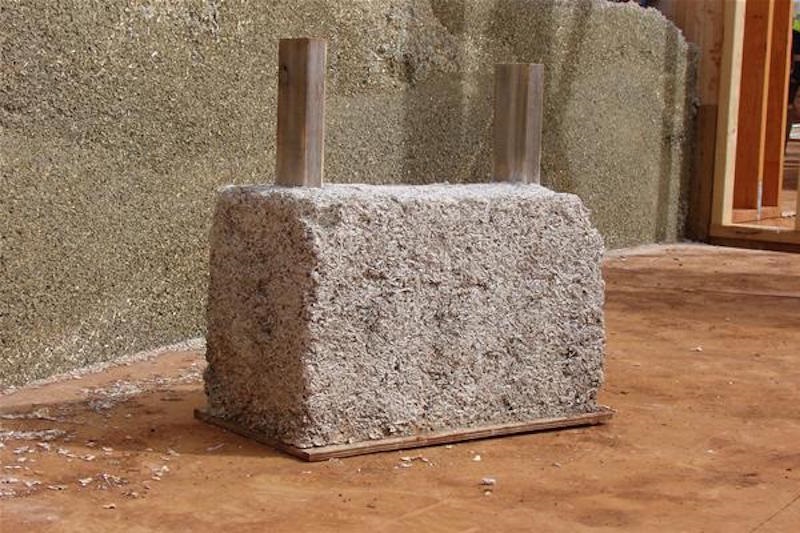Hempcrete
Contents |
[edit] Introduction
Hempcrete, also known as hemplime, is a bio-composite material that can be used in construction as an alternative to materials such as concrete and traditional insulation.
The basis of hempcrete is hemp, the balsa wood-like core (or ‘Shiv’) of a cannabis sativa plant. Hemp can be combined with lime and water to form hempcrete. The hemp has a high silica content, a unique property among natural fibres, which allows it to bind well with the lime. As a lightweight cementitious insulating material, it weighs only one-seventh to one-eighth that of concrete.
Hemp as a building material has been used across Europe for centuries, and as a modern building material, industrial hemp is now grown by certified commercial growers. The strain of plant grown for hempcrete contains 0.3% of THC, the ingredient in cannabis that provides its psychoactive nature. This is compared to the THC content found in hallucinogenic and medicinal varieties of between 5-10%.
While it is legally grown in Europe and Canada, growing hemp in America has been illegal for several decades. However, with the country’s gradual liberalisation of laws regarding the substance for medicinal and personal use, this may change.
[edit] Application
The material is mixed for 1-2 minutes before being applied, either into the wall cavities, or slip-forming with temporary timber or plastic shuttering. A hard render coating is generally applied as a finish on exterior surfaces with a thickness of around 20 mm. The interior can be left 'natural' or, for a traditional aesthetic, finished with lime plaster.
[edit] Properties
Hempcrete is very durable and has a number of other beneficial properties.
Similar to other natural plant products, carbon dioxide is absorbed from the atmosphere by hemp as it grows. During the curing process, as lime turns to limestone, the carbonation of the lime adds to this effect. As a result, hempcrete has a negative carbon footprint, with considerable potential for sustainable building.
It is able to naturally regulate a building’s humidity and temperature, which can reduce condensation and energy consumption, and improve thermal comfort for occupants. It provides natural insulation that is airtight, breathable and flexible. It is also toxin-free, impervious to mould and pests, and highly fire-resistant.
It is very suited to areas at risk of seismic activity since it is a low density material that is resistant to cracking under movement. The outer portion of the plant’s stalk can also provide fibres for building textiles.
However, hempcrete has a typical compressive strength of around 1 MPa, which is around 1/20 that of residential grade concrete, and has a density 15% that of concrete. This means that hempcrete walls must be used together with a load-bearing frame of another material.
[edit] Find out more
[edit] Related articles on Designing Buildings Wiki
- Blockwork.
- Cavity wall insulation.
- Cellular concrete.
- Composites.
- Concrete.
- Could the buildings of the future be made with bones and eggshells?
- Earth building.
- Floor insulation.
- Green building.
- Hemp lime construction: A guide to building with hemp lime composites.
- High alumina cement.
- K-Briq.
- Limecrete.
- Straw bale construction.
- Sustainability.
- Thermal insulation.
[edit] External resources
- American Lime Technology - What is hempcrete
Featured articles and news
Professional practical experience for Architects in training
The long process to transform the nature of education and professional practical experience in the Architecture profession following recent reports.
A people-first approach to retrofit
Moving away from the destructive paradigm of fabric-first.
International Electrician Day, 10 June 2025
Celebrating the role of electrical engineers from André-Marie Amperè, today and for the future.
New guide for clients launched at Houses of Parliament
'There has never been a more important time for clients to step up and ...ask the right questions'
The impact of recycled slate tiles
Innovation across the decades.
EPC changes for existing buildings
Changes and their context as the new RdSAP methodology comes into use from 15 June.
Skills England publishes Sector skills needs assessments
Priority areas relating to the built environment highlighted and described in brief.
BSRIA HVAC Market Watch - May 2025 Edition
Heat Pump Market Outlook: Policy, Performance & Refrigerant Trends for 2025–2028.
Committing to EDI in construction with CIOB
Built Environment professional bodies deepen commitment to EDI with two new signatories: CIAT and CICES.
Government Grenfell progress report at a glance
Line by line recomendation overview, with links to more details.
An engaging and lively review of his professional life.
Sustainable heating for listed buildings
A problem that needs to be approached intelligently.
50th Golden anniversary ECA Edmundson apprentice award
Deadline for entries has been extended to Friday 27 June, so don't miss out!
CIAT at the London Festival of Architecture
Designing for Everyone: Breaking Barriers in Inclusive Architecture.
Mixed reactions to apprenticeship and skills reform 2025
A 'welcome shift' for some and a 'backwards step' for others.






















